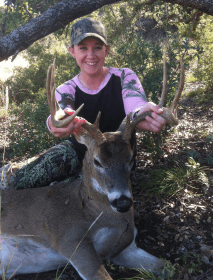- Home
- About
- Blog
- For Parents
-
Corners
- Allison’s Corner
- Amber’s Category
- Andrea’s Corner
- Ashley’s Corner
- Brandi Jo’s Corner
- Brittany’s Corner
- Brooke’s Corner
- Catrina’s Corner
- Conservation
- Desiree’s Corner
- Emily’s Corner
- Erica’s Corner
- Erin’s Corner
- Heather’s Corner
- Ivory’s Corner
- Jeana’s Corner
- Katie’s Corner
- Kelly’s Corner
- Kelsey’s Corner
- Kendra’s Corner
- Liberty’s Corner
- Lisa’s Corner
- Meagan’s Corner
- Melissa’s Corner
- Mimi’s Corner
- Morgan’s Corner
- Nicole’s Corner
- Sarah’s Corner
- Savannah’s Corner
- Shannon’s Blog
- Sharon’s Corner
- Sherri’s Corner
- Tara’s Corner
- Contact
- Guest Post

Management of Deer
I cannot stress the importance of wildlife management. We are not only hunters, but managers of these amazing creatures. I say that because when hunting, it’s of utmost importance to distinguish which mature animals to harvest, thereby increasing the stamina and numbers of the herd, and preventing starvation and over-population.
…
…
When looking for a doe to harvest, I’m looking for a very large, older doe. You can see the difference in the deer when you really observe them for a while, and see their body frame difference. Their heads and jaw line, as well as stomach and body change just as ours do as they age. Their skull widens, they become more pot-bellied in the stomach area. They typically stop having fawns, and you will not see the obvious milk signs on their milk bags. They will be more drawn up and dried up, not that you can get that close to see unless you’ve harvested an older doe. A lot of times it helps to see them amongst several other doe, and they will stick out like a sore thumb.
…
…
As far as a buck, they’re among the same body frame wise. Where their antlers are considered, you will hear many different observations on culls vs. non-culls, young vs. old, etc. If they have unusually large spikes is when our family harvests them, typically a 2&1/2 year old with only large spikes is what we consider a cull buck. If they are lacking dog catchers, brow tines to some of you, at pretty much 2&1/2 on, we consider them a cull buck. If they are a “mature 8,” meaning horns beyond their ears, which typically here means over 16 inches wide and at least 3&1/2 years old, we consider them a management or cull buck. We DO NOT consider small bucks with 3 points or small 4 points with no brow tines culls if they are only 1&1/2 because they are actually larger bucks for that age, especially free roaming, not protein fed, than most of the little spikes you will typically see.
…
…
The importance of these kinds of management practices is to cull out the least desirable bucks from the heard, or the oldest, NON baby-bearing does. By least desirable bucks I mean the genetic traits that you don’t want passed on horn-wise to the offspring, such as no dog catchers. This, in turn, increases the food supply for the deer by population control, and prevents over-population of many areas. We here in Texas are by no means in danger of low numbers of deer. They are actually still over-abundant in many areas, leading to starvation, especially in these droughts, and also auto accidents from the deer grazing on the sides of the most traveled highways. In many areas, Whitetail Deer and Axis can be found grazing in fields, and in the case of Axis, destroying crops. All of these problems associated with overpopulation contribute to a lot of money loss in the end.
…
Once you harvest a deer you can tell their age approximately, usually very close to actual age, by close examination of the wear of their teeth on their lower jaw in the back. Ag offices will gladly help you and teach you management practices as well. We participate in census lines here to best estimate the number of deer per acre, and the best harvest numbers, to better sustain the appropriate number of deer per acre, and buck per doe, for our area. Again, check with your Division of Wildlife for information for your area.
Jan 13, 2013 | Category: Blog, Conservation | Comments: 3

100% agree… it frustrates me to no end when I hear “I don’t shoot does, I’d rather shoot a young buck, gotta keep the females so you will have more deer”…. um… a piece of land can only support so many deer, male or female… we have met so many folks with that mentality…
And it is damn near impossible to get them to change their minds!
Thanks Steph, and very true! Hopefully people can get more of the word out, and with education efforts, they will soon understand the truth to management.
Harvesting old does and NOT shooting young bucks are two of the best things you can do to ensure a healthy herd. Combine these with proper range management, including “no go” or sanctuary zones that get zero pressure from people, and you’ll ensure a healthy deer population for years to come.
When we encounter fellow hunters who have misguided beliefs about deer management like those that Stephanie mentioned above, we owe it to ourselves to politely attempt to educate them. Asking them if you can give them some info from QDMA or other respected source goes a long way in fostering the overall health of the deer hunting community.
Jason in Texas